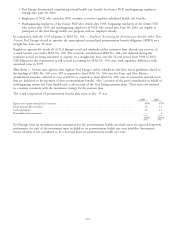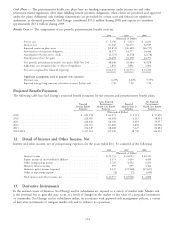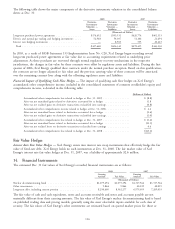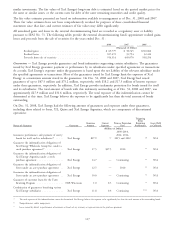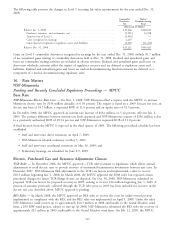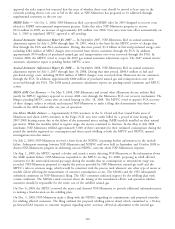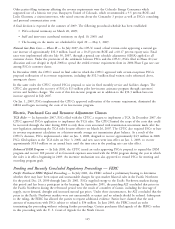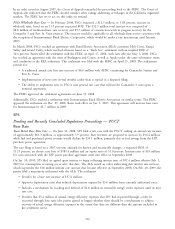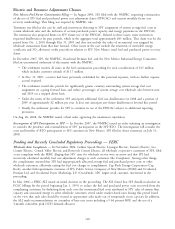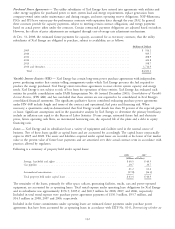Xcel Energy 2008 Annual Report Download - page 132
Download and view the complete annual report
Please find page 132 of the 2008 Xcel Energy annual report below. You can navigate through the pages in the report by either clicking on the pages listed below, or by using the keyword search tool below to find specific information within the annual report.is comparable to that filed with the MPUC. In February 2008, the NDPSC approved the request, indicating that
appropriate cost recovery levels would be determined in the pending electric rate case.
The SDPUC approved the NSP-Minnesota’s request to change the accounting method for nuclear refueling outage
operating and maintenance cost from a direct expense method to a method that amortizes these costs over the period
between outages.
MISO ASM Cost Recovery — On Dec. 24, 2008, NSP-Minnesota filed for NDPSC and SDPUC regulatory approval
to recover MISO ASM costs via an FCA cost recovery mechanism. NSP-Minnesota requested a regulatory order prior
to March 1, 2009, when ASM charges and revenues would affect the North Dakota and South Dakota FCA. On
Feb. 11, 2009, the NDPSC concluded that FCA treatment of these costs was already provided for by the rate case
settlement. Based on this information, NSP-Minnesota filed to withdraw its request. The MPUC granted the
withdrawal request at its Feb. 25, 2009 open meeting. On Feb. 12, 2009 the SDPUC approved NSP-Minnesota’s
request.
NSP-Minnesota South Dakota TCR and ECR Rate Riders — In December 2008, the SDPUC approved two rate riders
for recovery of transmission investments and environmental costs effective Feb. 1, 2009.
In February 2007, NSP-Minnesota filed a petition for approval of a tariff establishing a TCR rider for recovery of
certain transmission investments. The TCR rider rate is set to recover approximately $1.9 million during 2009. In
September 2007, NSP-Minnesota filed a petition for approval of a tariff establishing an environmental cost recovery
(ECR) rider for recovery of pollution control equipment installed at NSP-Minnesota’s A. S. King plant. The ECR Rider
rate is set to recover approximately $2.5 million during 2009.
Both rate riders were allowed a return on equity of 9.5 percent according to the terms of their respective settlement
agreements. However, if NSP-Minnesota makes a general rate filing utilizing a 2008 test year, the SDPUC may order
that an appropriate ROE value to be utilized under the rider mechanism, subject to true-up for the period from July 1,
2008 to the effective date of the order.
Pending and Recently Concluded Regulatory Proceedings — FERC
MISO Long-Term Transmission Pricing — In October 2005, MISO filed a proposed change to its TEMT to
regionalize future cost recovery of certain high voltage transmission projects. The tariff, called the Regional Expansion
Criteria Benefits tariff, would recover certain eligible transmission investments from all transmission service customers in
the MISO 15 state region. In November 2006, the FERC issued an order accepting the regional economic benefits
(RECB) I tariff, including a 20 percent limitation on the portion of transmission reliability expansion costs that would
be regionalized and recovered from all loads in the MISO region.
Transmission service rates in the MISO region have historically used a rate design in which the transmission cost
depends on the location of the load being served, which is referred to as license plate rates. Costs of existing
transmission facilities are thus not regionalized. In August 2007, MISO and its transmission owners filed a successor
rate methodology, to be effective February 2008. American Electric Power (AEP) filed a competing rate proposal that
would regionalize certain costs of the existing AEP system over the MISO and PJM RTO regions. The AEP proposal
would shift several million dollars in transmission costs annually to the NSP System. In January 2008, the FERC
rejected the AEP proposal. On Dec. 18, 2008, the FERC denied AEP’s request for rehearing.
Revenue Sufficiency Guarantee Charges — In April 2006, the FERC issued an order determining that MISO had
incorrectly applied its TEMT regarding the application of the revenue sufficiency guarantee (RSG) charge to certain
transactions. The FERC ordered MISO to resettle all affected transactions retroactive to April 2005. The RSG charges
are collected from MISO customers and paid to generators. In October 2006, the FERC issued an order granting
rehearing in part and reversed the prior ruling requiring MISO to issue retroactive refunds, and ordered MISO to
submit a compliance filing to implement prospective changes.
In March 2007, the FERC issued orders separately denying rehearing of the FERC order. Several parties filed appeals to
the U.S Court of Appeals for the District of Columbia seeking judicial review of the FERC’s determinations of the
allocation of RSG costs among MISO market participants. Xcel Energy intervened in each of these proceedings. In
August 2007, Ameren Services Company (Ameren) and the Northern Indiana Public Service Company (NIPSCO) filed
a joint complaint against MISO at the FERC, challenging the MISO’s FERC-approved methodology for the recovery of
RSG costs. In November 2007, the FERC issued an order instituting a proceeding to review evidence and to establish a
RSG cost allocation methodology for market participants under the MISO TEMT. In March 2008, the MISO filed
122


